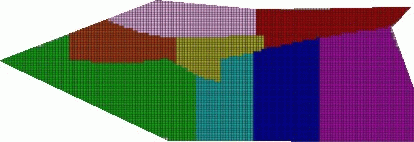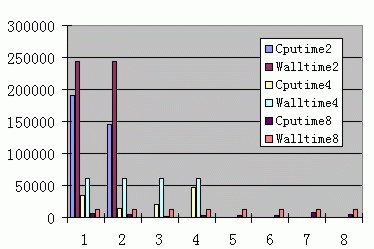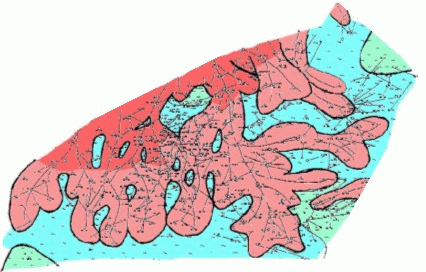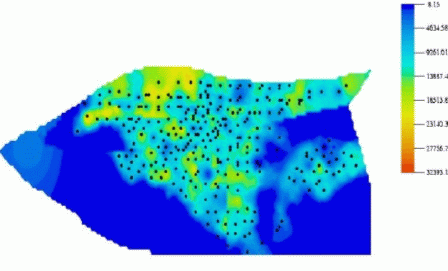| |
Reservoir simulation is a developing application technique for reservoir development and management. It can be used to forecast the production behavior of oil and gas fields, optimize reservoir development schemes, and evaluate the distribution of remaining oil through history matching, for example. It is an important tool to help reservoir engineers optimize the design of well development schemes, improve the efficiency of reservoir development, and enhance oil and gas recovery. |
Here you will find some of the recent developments in the
Reservoir Simulation Group led by Dr. John Chen in the following
aspects:
|
| |
The governing equations that describe multiphase flow in reservoirs are nonlinear and coupled. They can be rewritten in different differential formulations so that the coupling and nonlinearity of these equations are weakened, efficient and accurate numerical methods can be devised, and simulation time can be reduced. Various formulations of the governing equations, including phase, global, and weighted formulations have been studied and compared for two-phase, black-oil, and compositional flows. |
| |
The software we have developed for numerical reservoir
simulation includes scanners which
|
The software is also able to
|
| |
Many discretization methods have been applied
to the numerical solution of
the flow and transport equations in reservoirs. These methods
range from finite difference methods, finite element methods,
discontinuous finite element methods,
control volume finite element methods, mixed finite element
methods, to control volume function approximation methods.
Their limitation, efficiency, accuracy, flexibility, and
applicability to reservoir simulation have been described and
compared. In particular, we have developed and applied
the control volume function approximation method which
|
| |
Fast and accurate solution of linear systems of algebraic equations that arise from the discretization of the governing equations for multiphase flows has been increasingly important. In a numerical reservoir simulator, about 80% of time is spent on the solution of these systems. Various iterative solvers such as ORTHOMIN (orthogonal minimum residual), GMRES (generalized minimum residual), FGMRES (Flexible GMRES), and BiCGSTAB (biconjugate gradients stabilized) and their preconditioned versions have been considered and compared. Particularly, these solvers and their parallel versions for solving linear systems arising from discretization methods on unstructured grids have been applied. The preconditioners include ILUT (dual threshold incomplete LU factorization), ILUK (incomplete ILU with level of fill), and multilevel and domain decomposition based approaches. |
| |
Since the fluid flow and transport models in reservoirs involve large, coupled systems of nonlinear, time-dependent partial differential equations, an important problem in numerical reservoir simulation is to develop stable, efficient, robust, accurate, and self-adaptive solution schemes. The iterative IMPES (implicitly in pressure and explicitly in saturation), sequential (pressure, saturation, and concentration equations decoupled and each solved implicitly), and fully implicit (simultaneous, implicit solution of all equations) solution schemes have been studied and compared for two-phase, black-oil, and compositional flows. Recently, we have developed an improved IMPES scheme for solving two-phase flow in three-dimensional reservoirs. This improved scheme utilizes an adaptive control strategy on the choice of time steps for saturation and takes much larger time steps for pressure than for saturation. It is capable of solving two-phase coning problems. |
| |
We have developed parallel codes for thermal simulation of multicomponent, multiphase fluid flow in petroleum reservoirs. These codes utilize the message passing interface (MPI) library, overlapping domain decomposition, and dynamic memory allocation techniques. Their efficiency has been investigated through simulation of three-dimensional multicomponent, multiphase field models for heavy oil crudes. Numerical results for these simulation models indicate that these parallel codes can significantly improve capacity and efficiency for large-scale thermal simulation. |
 |
 |
 |
 |
| |
A successful application of visualization technology
to reservoir simulations can help reservoir engineers study
more accurately physical data such as the porosity, permeability,
depth, and thickness of reservoirs, construct more accurate
geological and flow models, and perform more realistic simulations.
It also helps them view and analyze water, oil, and gas distribution
and history matching. As simulation technology gets more advanced,
there are new requirements from reservoir engineering.
These requirements include the real-time display of
production behavior of oil/gas fields and of flow
streamline maps for understanding
the essentials of oil recovery processes,
the visualization of remaining oil distribution
in reservoir layers, the management of drilling
new wells, the shortening of history match processes,
and interactive capabilities for new design of
development projects of oil/gas fields.
We have developed visualization software which
has most of these features. In particular, it
|
| |
The models in our reservoir simulators feature
|
Our numerical reservoir simulators can apply to
|
| |
We have had research collaborations with some of
oil companies such as Mobil Technology Company
and PDVSA-Intevep, Venezuela
and had experiences with applications of our
numerical reservoir simulators to oil fields such as
|
|
Last revision: November 7, 2002.